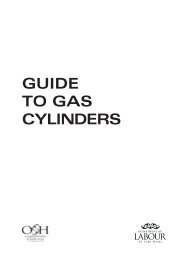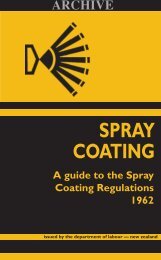Temperature in Places of Work - Health and Safety - Department of ...
Temperature in Places of Work - Health and Safety - Department of ...
Temperature in Places of Work - Health and Safety - Department of ...
You also want an ePaper? Increase the reach of your titles
YUMPU automatically turns print PDFs into web optimized ePapers that Google loves.
TEMPERATURE <strong>in</strong> places <strong>of</strong> work<br />
What is thermal discomfort?<br />
What you need to know about<br />
Thermal discomfort<br />
Thermal discomfort is the uncomfortable place between a<br />
thermal environment that is ideal, <strong>and</strong> one that will cause a<br />
person to be harmed.<br />
A person feel<strong>in</strong>g thermal discomfort will feel either too hot or<br />
too cold. However, a person will not suffer harm as a direct<br />
result <strong>of</strong> the thermal environment.<br />
Should people be allowed to experience thermal discomfort at<br />
work?<br />
While a thermal environment that causes discomfort may not<br />
directly cause harm, it does have many disadvantages. People<br />
can feel tired <strong>and</strong> irritable. They may be less productive <strong>and</strong><br />
make more mistakes with their work. There’s a greater risk <strong>of</strong><br />
someone mak<strong>in</strong>g a mistake that could result <strong>in</strong> an accident.<br />
It’s therefore not desirable for people to work <strong>in</strong> thermally<br />
uncomfortable conditions. This is reflected by the <strong>Health</strong> <strong>and</strong><br />
<strong>Safety</strong> <strong>in</strong> Employment Regulations 1995, which put duties on<br />
employers to provide facilities to control the thermal<br />
environment. These are outl<strong>in</strong>ed <strong>in</strong> Sheet 9: Legislation.<br />
In many work situations, it may not be possible to avoid some<br />
thermal discomfort. The thermal environment obviously cannot<br />
be controlled for people work<strong>in</strong>g outdoors, although cloth<strong>in</strong>g,<br />
physical activity <strong>and</strong> the tim<strong>in</strong>g <strong>of</strong> the work can be. If people<br />
experience discomfort for only a few days a year, it may not be<br />
practicable to spend a lot <strong>of</strong> resources to control the thermal<br />
environment. Adm<strong>in</strong>istrative controls may be more appropriate.<br />
Is there a maximum <strong>and</strong> m<strong>in</strong>imum temperature employees<br />
should be exposed to?<br />
It’s very difficult to give a maximum or m<strong>in</strong>imum level based on<br />
air temperature alone. All the six ma<strong>in</strong> factors outl<strong>in</strong>ed <strong>in</strong> Sheet<br />
2 will affect how people perceive temperature. If employees are<br />
experienc<strong>in</strong>g discomfort, some form <strong>of</strong> control will be necessary.<br />
Control options are outl<strong>in</strong>ed <strong>in</strong> Sheets 6 <strong>and</strong> 7: Control Options<br />
for Hot/Cold Situations. An OSH <strong>in</strong>spector would not ask for<br />
improvement <strong>of</strong> a situation without <strong>in</strong>vestigat<strong>in</strong>g <strong>and</strong> be<strong>in</strong>g<br />
satisfied that <strong>in</strong>tervention was necessary.<br />
ISSUED BY THE OCCUPATIONAL SAFETY AND HEALTH SERVICE, DEPARTMENT OF LABOUR, WELLINGTON, NEW ZEALAND<br />
3730GFO DECEMBER 1997<br />
OCCUPATIONAL SAFETY<br />
& HEALTH SERVICE<br />
DEPARTMENT OF<br />
LABOUR<br />
TE TARI MAHI<br />
Information Sheet No. 4<br />
Cont<strong>in</strong>ued over





